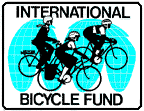Morocco: Bicycle Tour Travel Guide

![]() IBF is 100%
IBF is 100%
solar powered
![]()
by David Mozer
[An introduction and overview to travel in Africa is available by clicking here. If you are look for a bicycle tour to this country, this link might help you.]
The information below may have been extracted from a more comprehensive "Country Supplement" to the book "Bicycling In Africa". For information on these publications click on the links.
Morocco has 16,000 miles of paved roads. Fortunately most of the driving occurs on a small fraction of these, but you want to be wary of a Moroccan driver wherever you meet them. Especially in congested areas, sharing the roads is a foreign concept.
A second concern for the cycle tourist is Morocco's reputation for theft and scams, especially in the markets of the big cities. Although most of the population is helpful hospitable and honest, the negative element makes traveling rougher. Take care of your belongs all over the country and be alert when young men approach you. Women traveling alone should also be "street-wise" in there behavior and acceptance of offers for help.
Atlantic Coast Region: Because of its relatively mild climate this area can be used for cycling almost year around. A good road winds around the coast south of Casablanca to Safi, Essouira and Agadir. There are a dozen roads from the main, heavily traveled, Fes-Marrakech route to the Atlantic. A half-dozen routes to Casablanca alone. As a rule the ones that offer the least direct access to the big cities offer the best bicycling.
Rif Mountain Region: The Rif mountain region includes the road from Tetouan to Melilla and Oujda, and the parallel mountain range to the south. The area is famous for its hashish production, which presents a tremendous problem for the hapless cyclist. They can be harassed by a constant barrage of hashish sellers. The police are suspicious of foreigners and can add to the cyclist's dilemma. Drugs breed other crimes. However beautiful, the area is not recommended for cycling.
Atlas Mountains: The Atlas mountains (which include the Moyen (middle) Atlas, Haut (high) Atlas, and Anti Atlas) are beautiful, but they are jagged and tough to ride. There are passes well above 2000m (6500 feet) that are often shrouded in fog and have reduced visibility. You have to cross to get to or from the inland desert region, but if you are up to the task it opens up the options of some very diverse and exciting loops.
Inland Desert: The eastern desert has few roads, but for those who want to work hard enough there are great rewards. The sparse population in the area has not seen as many tourists so they offer a more natural hospitality. The route from Midelt to Marrakech offers many scenic sections, and those which are not overtly scenic are nicely spiritual. Be prepared with sufficient food and water in any season as services are limited. Note that temperatures get up to 40oC (104oF) in the hot months.
Western Sahara: What is shown on many maps as Morocco's southern desert (starting just south of Tarfara) is the former Western Sahara. For decades this was a military zone closed to travel. Peace accords have been signed and the region is opening up again for travel. There are thousands of unexploded mines in the Western Sahara and in areas of Mauritania adjacent to the Western Sahara border. Exploding mines are occasionally reported, and they have caused death and injury. Transit to the Western Sahara remains restricted; persons planning to travel in the region may obtain information on clearance requirements from the Moroccan Embassy.
Summary: Morocco offers a wide range of ambitious and not so ambitious routes. If you have about four weeks, want a challenge and enjoy the variety of surf, plains, mountains and sand you can make a nice loop through the midsection of the country. There are a number of variations that can be made, but the basic route is: Casablanca, Meknes, Midelt, Er-Rachidia, Ouarzazate, Marrakech, Safi, Casablanca. For easier experience stay in the relatively flatter regions near the Atlantic coast.
Links of Interest:
Regional Resources:
Algeria
Mauritania
Mali
Senegal
Tunisia
For current news on Africa and more web sites with country-by-country information go to the link section and click on "Africa: News, Background, Travel."
Home | About Us | Contact Us | Contributions | Economics | Education | Encouragement | Engineering | Environment | Bibliography | Essay Contest | Ibike Tours | Library | Links | Site Map | Search
![]()
The International Bicycle Fund is an independent, non-profit organization. Its primary purpose is to promote bicycle transportation. Most IBF projects and activities fall into one of four categories: planning and engineering, safety education, economic development assistance and promoting international understanding. IBF's objective is to create a sustainable, people-friendly environment by creating opportunities of the highest practicable quality for bicycle transportation. IBF is funded by private donation. Contributions are always welcome and are U.S. tax-deductible to the extent allowed by law.
![]()
![]() Please write if you have questions, comment, criticism, praise or
additional information for us, to report bad links, or if you would like to be
added to IBF's mailing list. (Also let us know how you found this site.)
Please write if you have questions, comment, criticism, praise or
additional information for us, to report bad links, or if you would like to be
added to IBF's mailing list. (Also let us know how you found this site.)
